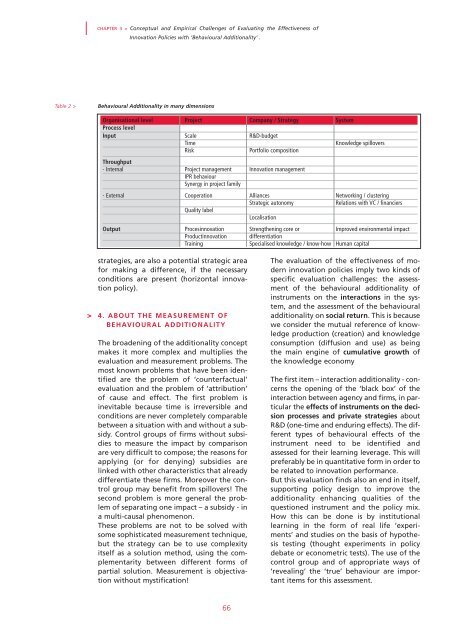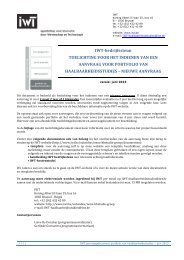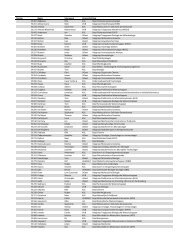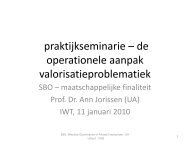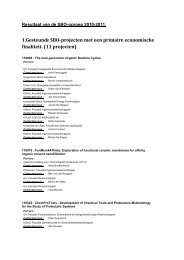The Evaluation of 'Behavioural Additionality' - IWT
The Evaluation of 'Behavioural Additionality' - IWT
The Evaluation of 'Behavioural Additionality' - IWT
Create successful ePaper yourself
Turn your PDF publications into a flip-book with our unique Google optimized e-Paper software.
CHAPTER 3 > Conceptual and Empirical Challenges <strong>of</strong> Evaluating the Effectiveness <strong>of</strong><br />
Innovation Policies with ‘Behavioural Additionality’ .<br />
Table 2 ><br />
Behavioural Additionality in many dimensions<br />
Organisational level Project Company / Strategy System<br />
Process level<br />
Input Scale R&D-budget<br />
Time<br />
Knowledge spillovers<br />
Risk<br />
Portfolio composition<br />
Throughput<br />
- Internal Project management Innovation management<br />
IPR behaviour<br />
Synergy in project family<br />
- External Cooperation Alliances Networking / clustering<br />
Strategic autonomy<br />
Relations with VC / financiers<br />
Quality label<br />
Localisation<br />
Output Procesinnovation Strengthening core or Improved environmental impact<br />
Productinnovation differentiation<br />
Training Specialised knowledge / know-how Human capital<br />
><br />
strategies, are also a potential strategic area<br />
for making a difference, if the necessary<br />
conditions are present (horizontal innovation<br />
policy).<br />
4. ABOUT THE MEASUREMENT OF<br />
BEHAVIOURAL ADDITIONALITY<br />
<strong>The</strong> broadening <strong>of</strong> the additionality concept<br />
makes it more complex and multiplies the<br />
evaluation and measurement problems. <strong>The</strong><br />
most known problems that have been identified<br />
are the problem <strong>of</strong> ‘counterfactual’<br />
evaluation and the problem <strong>of</strong> ‘attribution’<br />
<strong>of</strong> cause and effect. <strong>The</strong> first problem is<br />
inevitable because time is irreversible and<br />
conditions are never completely comparable<br />
between a situation with and without a subsidy.<br />
Control groups <strong>of</strong> firms without subsidies<br />
to measure the impact by comparison<br />
are very difficult to compose; the reasons for<br />
applying (or for denying) subsidies are<br />
linked with other characteristics that already<br />
differentiate these firms. Moreover the control<br />
group may benefit from spillovers! <strong>The</strong><br />
second problem is more general the problem<br />
<strong>of</strong> separating one impact – a subsidy - in<br />
a multi-causal phenomenon.<br />
<strong>The</strong>se problems are not to be solved with<br />
some sophisticated measurement technique,<br />
but the strategy can be to use complexity<br />
itself as a solution method, using the complementarity<br />
between different forms <strong>of</strong><br />
partial solution. Measurement is objectivation<br />
without mystification!<br />
<strong>The</strong> evaluation <strong>of</strong> the effectiveness <strong>of</strong> modern<br />
innovation policies imply two kinds <strong>of</strong><br />
specific evaluation challenges: the assessment<br />
<strong>of</strong> the behavioural additionality <strong>of</strong><br />
instruments on the interactions in the system,<br />
and the assessment <strong>of</strong> the behavioural<br />
additionality on social return. This is because<br />
we consider the mutual reference <strong>of</strong> knowledge<br />
production (creation) and knowledge<br />
consumption (diffusion and use) as being<br />
the main engine <strong>of</strong> cumulative growth <strong>of</strong><br />
the knowledge economy<br />
<strong>The</strong> first item – interaction additionality - concerns<br />
the opening <strong>of</strong> the ‘black box’ <strong>of</strong> the<br />
interaction between agency and firms, in particular<br />
the effects <strong>of</strong> instruments on the decision<br />
processes and private strategies about<br />
R&D (one-time and enduring effects). <strong>The</strong> different<br />
types <strong>of</strong> behavioural effects <strong>of</strong> the<br />
instrument need to be identified and<br />
assessed for their learning leverage. This will<br />
preferably be in quantitative form in order to<br />
be related to innovation performance.<br />
But this evaluation finds also an end in itself,<br />
supporting policy design to improve the<br />
additionality enhancing qualities <strong>of</strong> the<br />
questioned instrument and the policy mix.<br />
How this can be done is by institutional<br />
learning in the form <strong>of</strong> real life ‘experiments’<br />
and studies on the basis <strong>of</strong> hypothesis<br />
testing (thought experiments in policy<br />
debate or econometric tests). <strong>The</strong> use <strong>of</strong> the<br />
control group and <strong>of</strong> appropriate ways <strong>of</strong><br />
‘revealing’ the ‘true’ behaviour are important<br />
items for this assessment.<br />
66


